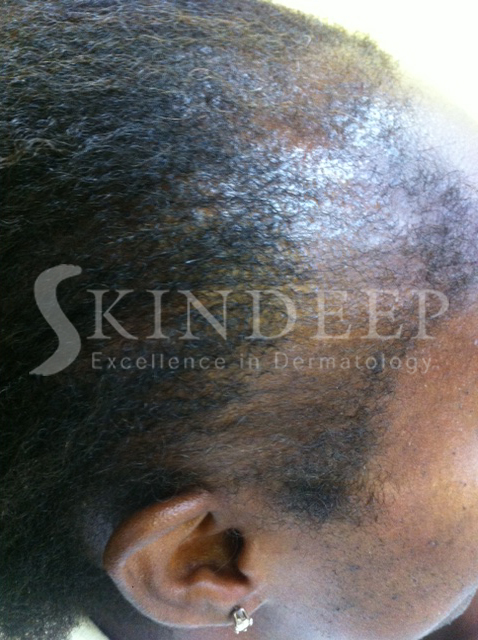Traction alopecia is a form of non-scarring hair loss predominantly affecting the hairline and is due to prolonged tension on the hair follicles. The condition was first described in 1907, by the Austrian dermatologist Trebitsch, affecting women from Greenland who liked to wear tight ponytail hairstyles. All ethnic backgrounds are affected. The likelihood acquiring this alopecia and the severity of hair loss increases with age. This is one of the most common forms of alopecia in Barbados due to our prolonged cultural practice of inappropriately tight hairstyles.

Specific hairstyles are associated with this symmetrical hair loss occurring above and anterior to the ears. The entire frontal and occipital (back of the head) can be affected. The “fringe sign” is commonly observed where short broken hair is retained along the peripheral rim of the hairline followed by a band of alopecia and healthy hair. Regularly wearing tight cornrows, dreadlocks, braids, weaves, plaits and chignon hairstyles should be avoided at all costs. Extensions and the use of tight rollers at night can have a similar effect. In some of these cases the sheer weight of the hair contributes and exacerbates the process.
Itching and redness along with pinhead like pustules along the hairline are the early signs of the process. Many school age children exhibit this phenomenon which is unappreciated by their parents. Sometimes this is incorrectly assumed to be a bacterial infection. Later there may be mild dryness and multiple broken hairs, which look fuzzy or have to be secured with pins or gels. This signals the necessity for intervention that is unfortunately too often ignored. Thinning and hair loss finally occurs with a smooth scalp and the absense of follicular opening. Columns of fibrosis replace the once healthy hair follicles. This end stage is not reversible. The new receded hairline is now subject to the same destructive forces if the hairstyles are maintained and this leads to worsening of the condition.
Early recognition and intervention is necessary to prevent irreversible alopecia. The changing of hair care and styling practices prevent further deterioration and complete recovery in early stages. In many cases the hairstyle, which resulted in the condition, have been long abandoned due to the need to hide the alopecia. This can make some individuals reluctant to accept traction as the underlying cause. These situations of denial are always challenging.
Patients with longstanding disease require hair transplantation as their definitive treatment. Previously flaps were used but this method is outdated. Topical Minoxidil as well as topical or intralesional steroids have been used with varied results. Wigs can also be used to hide the deficit. In the early stages some resort to the use of dye along the anterior hairline.
There is an important relationship between hair, beauty and a sense of well being. Hair loss can have significant negative emotional effects on those who are affected. It is best to allow your dermatologist determine the cause of your hair loss using clinical skills and various tests to allow early intervention.

